| Latest | Greatest | Lobby | Journals | Search | Options | Help | Login |
|
|
|
This topic is archived. |
| Home » Discuss » Topic Forums » Sports |
|
| Jack Rabbit
|
Sun Jul-26-09 02:44 PM Original message |
| The JR Chess Report (July 26): Chuckie leads Biel; Last-round dramatics in Denmark |
|
Ivanchuk Leads in Biel after Six Rounds
 Ukrainian grandmaster Vassily Ivanchuk leads the category 19 Grandmaster Tournament of the 42nd Biel Internaltional Chess Festival in Switzerland after six round with 3½ points. Ivanchuk, one of the most popular figures in the sport, has only a single victory and five draws. One point seperates the head from the foot of the six-player table. Three-time tournament champion Alexander Morozevich of Russia took the early lead with victories in each of the first two rounds, but fell behind Ivanchuk with losses in rounds four and six. In addition to Morozevich in second place at 50 precent, three other players are tied with him: the defending tournament champion, Russian GM Evgeny Alekseev; Maxime Vachier Lagrave of France; and GM Fabiano Caruana, the Brooklyn teenager who is the reigning Italian national champion. Today is an off-day for the players. The tournament resumes tomorrow with round seven when Ivanchuk plays White against Alekseev, while Morozevich will hope to start a comeback playing Black against Israel's Boris Gelfand, the event's top seed. The tenth and final round of the tournament will be played Thursday. Live games are boadcast on the Official Website of the Chess Fesival beginning at 2 pm Swiss time (5 am PDT). Negi and Avrukh take Politiken Cup with Dramatic Last-Round Wins  Sixteen-year-old Indian grandmaster Parimarjan Negi and former two-time Israeli national champion Boris Avrukh won dramatic victories in today's tenth and final round of the Politiken Cup open tournament in Helsignør, Denmark to share first prize with 8½ points each. Avrukh, playing White, defeated Russian GM and tournament top seed Vladimir Malakhov, who entered the final round alone in first, needing only a draw to assure himself a share of first prize. The game lasted 36 moves. Meanwhile, Negi, also playing White, disposed of Swedish national champion Emanuel Berg in just 28 moves. Malakhov finished in a five-way tie for third place with grandmasters Gabriel Sargissian (Armenia), Peter Heine Nielsen (Denmark), Evgeny Postny (Israel) and former two-time Dutch national champion Sergei Tiviakov. Over two hundred players competed in this year's Politiken Cup. The event was part of the Copenhagen Chess Festival. Helsingør, the old royal capital, is about 25 miles from Copenhagen. It is better known to us Shakespeare buffs as Elsinore, the setting for Hamlet. Calendar Pan-American Continental Championship, São Paulo 25 July-2 August. Mainz Chess Classic 27 July-2 August. US Open, Indianapolis 1-9 August. FIDE Grand Prix, Yerevan 8-24 August. Howard Staunton Memorial, London 8-17 August. Played at historic Simpson's Divan. International Festival d'échecs, Montreal 27 August-7 September. Grandmaster Tournament will include Bacrot, Onischuk, Shulman, Naiditsch and Maze; more to be added. Grand Slam Final, Bilbao 2-15 September. Topalov, Karjakin, Grischuk and Shirov qualify. Second Pearl Spring Tournament, Nanjing 27 September-9 October. Topalov, Anand, Carlsen, Radjabov, Jakovenko and Wang Yue. World Junior Championship, Mar del Plata (Argentina) 16-29 October. European Club Cup (Team Championship), Novi Sad (Serbia) 21-31 October. World Cup, Khanty Mansiysk 28 November-15 December. London Chess Classic 7-16 December. Corus Chess Tournament, Wijk aan Zee 15-31 January 2010. Nakamura has been invited to play in group A. Anand-Topalov Match for the World Title, Site TBA c. April 2010. This Week's Games will be posted later today. |
| Printer Friendly | Permalink | | Top |
| Jack Rabbit
|
Sun Jul-26-09 05:21 PM Response to Original message |
| 1. This week's games |
|
Your humble hare acknowledges the assistance of Fritz 6.0 on analysis. Diagrams on the Jack Rabbit Chess Report are made with Chess Mérida, a true type font that can be downlaoded free here. !""""""""# $tMvWlVmT% $OoOoOoOo% $ + + + +% $+ + + + % $ + + + +% $+ + + + % $pPpPpPpP% $RnBqKbNr% /(((((((() WHITE White to move (This position is a theoretical draw) |
| Printer Friendly | Permalink | | Top |
| Jack Rabbit
|
Sun Jul-26-09 05:23 PM Response to Reply #1 |
| 2. Grandmaster Tournament, 42nd Biel Chess Festival |
| Printer Friendly | Permalink | | Top |
| Jack Rabbit
|
Sun Jul-26-09 05:23 PM Response to Reply #2 |
| 3. Ivanchuk - Caruana, Round 3 |
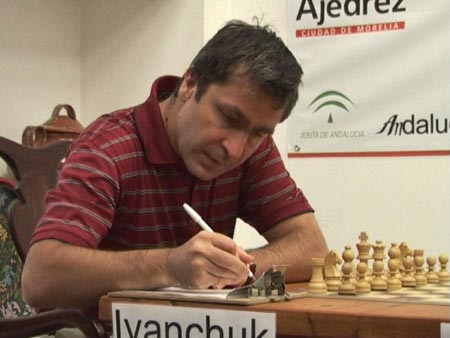 Vassily Ivanchuk Vassily Ivanchuk - Fabiano Caruana 42nd International Chess Festival, Round 3 Biel, 21 July 2009 Spanish Petit Royal Game: Four Knights' Opening (Bedspring Defense) (Rubinstein Defense) 1.e4 e5 2.Nf3 Nc6 3.Nc3 Nf6 4.Bb5 Nd4
5.Ba4
5...c6
6.Nxe5 d5
7.d3 Bd6 8.Nf3
8...Bg4 9.Be3 Nxf3+
10.gxf3 Bh5 11.exd5 0-0 12.dxc6 bxc6 13.Rg1 Nd5?
!""""""""# $t+ W Tl+% $O + +oOo% $ +oV + +% $+ +m+ +v% $b+ + + +% $+ NpBp+ % $pPp+ P P% $R +qK R % /(((((((() WHITE: Vassily Ivanchuk Position after 13...Nf6d5 14.Nxd5!
14...cxd5 15.Rg5 d4 16.Rxh5 dxe3 17.fxe3 g6
18.Rh3 Qb6 19.Kf2 Qxb2 20.d4 Rac8
21.Bb3 Rxc2+
22.Qxc2
22...Qxa1 23.f4 Qh1 24.Qc4 a5 25.Qf1
25...Qxf1+ 26.Kxf1 Kg7 27.f5
27...gxf5 28.Bc2 Rc8
29.Bxf5 Rc1+ 30.Ke2 h6 31.Be4 a4 32.Rh4 a3
33.Rg4+ Kf6 34.h3 Bc7 35.Bd5
35...Rc2+ 36.Kd3 Rf2 37.Rg8 Bd6
38.Ra8 Kg7 39.Ra6 Bb4 40.Ra7 Bf8 41.e4 h5
42.Ke3 Rf6 43.e5 Rf5 44.Ke4 Rf2 45.Ke3 Rf5 46.Ke4 Rf2 !""""""""# $ + + V +% $R + +oK % $ + + + +% $+ +bP +o% $ + Pk+ +% $O + + +p% $p+ + t +% $+ + + + % /(((((((() WHITE: Vassily Ivanchuk Position after 46...Rf5f2 47.e6!!
47...Kg6 48.Ke3 Rf1 49.Ke2 1-0
|
| Printer Friendly | Permalink | | Top |
| Jack Rabbit
|
Sun Jul-26-09 05:24 PM Response to Reply #2 |
| 4. Morozevich - Alekseev, Round 1 |
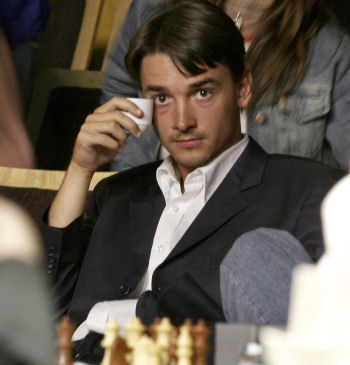 Alexander Morozevich Alexander Morozevich - Evgeny Alekseev 42nd International Chess Festival, Round 1 Biel, 19 July 2009 East India Game: Nimzo-Indian Defense (Keres Variation) 1.d4 Nf6 2.c4 e6 3.Nc3 Bb4 4.Qc2 0-0 5.a3 Bxc3+ 6.Qxc3 d5
7.cxd5
7...Ne4 8.Qc2 exd5 9.Bf4!?
!""""""""# $tMbW Tl+% $OoO +oOo% $ + + + +% $+ +o+ + % $ + PmB +% $P + + + % $ Pq+pPpP% $R + KbNr% /(((((((() WHITE: Alexander Morozevich Position after 9.Bc1f4 9...Bf5!?
10.Qxc7 Qxc7 11.Bxc7 Rc8
12.Bf4 Rc2 13.f3 Nf6 14.g4 Bg6 15.h4 Rxb2
16.h5 Bc2 17.e3 Ba4
18.Rh2 Rb3
19.Ne2!
19...Nbd7 20.g5 Ne8 21.Nc1 Rb6 22.Na2 Nf8 23.Nb4 Rd8
24.h6!?
24...Ne6 25.hxg7
!""""""""# $ + Tm+l+% $Oo+ +oPo% $ T +m+ +% $+ +o+ P % $vN P B +% $P + Pp+ % $ + + + R% $R + Kb+ % /(((((((() WHITE: Alexander Morozevich Position after 25.hg7:p 25...Nxf4!
26.exf4 Nxg7 27.Bd3
27...Ne6 28.f5 Nf4!?
29.f6!
29...h5?
30.Kf2 a5
31.Kg3 Ng6
!""""""""# $ + T +l+% $+o+ +o+ % $ T + Pm+% $O +o+ Po% $vM P + +% $P +b+pK % $ + + + R% $R + + + % /(((((((() WHITE: Alexander Morozevich Position after 31...Nf4g6 32.Rxh5!!
32...axb4 33.Rah1 bxa3 34.Rh7 1-0
|
| Printer Friendly | Permalink | | Top |
| Jack Rabbit
|
Sun Jul-26-09 05:26 PM Response to Reply #2 |
| 5. Caruana - Morozevich, Round 4 |
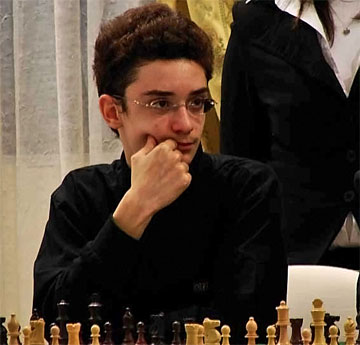 Fabiano Caruana Fabiano Caruana - Alexander Morozevich 42nd International Chess Festival, Round 4 Biel, 23 July 2009 West India Game: Indian Queen's Gambit (Exchange Opening) (Grünfeld Defense) 1.d4 Nf6 2.c4 g6 3.Nc3 d5 4.cxd5 Nxd5 5.e4 Nxc3 6.bxc3 Bg7 7.Bc4
7...c5 8.Ne2 0-0 9.0-0 Nc6 10.Be3 Qc7
11.Rc1 Rd8 12.Bf4
12...Be5
13.Bg3 Bxg3 14.fxg3 Rf8!?
15.h3
15...Na5 !""""""""# $t+v+ Tl+% $OoW Oo+o% $ + + +o+% $M P + + % $ +bPp+ +% $+ P + Pp% $ + +n+p+% $+ Rq+rK % /(((((((() WHITE: Fabiano Caruana Position after 15...Nc6a5 16.Bd3!?
16...e5 17.Qd2 Qe7!?
18.g4!
18...Bd7 19.d5!?
19...c4
20.Bc2 f6 21.Ng3 b6 22.Bd1 Nb7 23.Be2
23...Nd6 24.Rf2 Rac8 25.Rcf1 Kg7
26.Qe3 h6 !""""""""# $ +t+ T +% $O +v+ L % $ O M OoO% $+ +pO + % $ +o+p+p+% $+ P Q Np% $p+ +bRp+% $+ + +rK % /(((((((() WHITE: Fabiano Caruana Position after 26...h7h6 27.Rb1!?
27...Rc5
28.Bd1
28...Ra5 29.Qd2 Be8 30.Be2 Qc7 31.Rbf1 Rf7
32.h4 Qe7 33.Qc2
33...b5 34.Qb1 Qd8 35.Bd1
35...Qb6 36.Kh2 Qc5 37.Qc1
37...Ra6 38.Qd2 Rb6 39.Bc2 Rbb7 40.Qc1 a5 41.a3!?
41...Rb8!?
42.Bd1 Bd7 43.Be2 Rh8 44.Qa1
!""""""""# $ + + + T% $+ +v+tL % $ + M OoO% $OoWpO + % $ +o+p+pP% $P P + N % $ + +vRpK% $Q + +r+ % /(((((((() WHITE: Fabiano Caruana Position after 44.Qc1a1 44...h5!?
45.gxh5 f5 46.exf5 gxf5 47.Qb1?
47...Qe3?
48.Bg4!
48...Qd3?!
49.Qe1!
49...Re8
50.Rf3 Qxd5 51.Bxf5 e4?
!""""""""# $ + +t+ +% $+ +v+tL % $ + M + +% $Oo+w+b+p% $ +o+o+ P% $P P +rN % $ + + +pK% $+ + Qr+ % /(((((((() WHITE: Fabiano Caruana Position after 51...e5e4 52.Bxe4!
52...Qe5 53.h6+ Kf8
54.Rxf7+ Nxf7 55.Qf2 Re7 56.Bg6 Be8 57.Qf6 Qxf6 58.Rxf6 Kg8 59.Nf5 1-0
|
| Printer Friendly | Permalink | | Top |
| Jack Rabbit
|
Sun Jul-26-09 07:59 PM Response to Reply #1 |
| 6. Politiken Cup, Helsigøor |
| Printer Friendly | Permalink | | Top |
| Jack Rabbit
|
Sun Jul-26-09 08:04 PM Response to Reply #6 |
| 7. Negi - Nielsen, Round 7 |
 Parimarjan Negi Parimarjan Negi - Peter Heine Nielsen Politiken Cup, Round 7 Helsingør, 23 July 2009 Open German Game: Spassky Opening 1.e4 c6 2.d4 d5 3.Nc3 dxe4 4.Nxe4 Bf5 5.Ng3 Bg6 6.h4 h6 7.Nf3 Nd7 8.h5
8...Bh7 9.Bd3 Bxd3 10.Qxd3 e6 11.Bd2
11...Ngf6 12.0-0-0
12...Be7
13.Rhe1
13...0-0 14.Qe2 a5 15.Ne5 a4!?
16.a3
16...c5 17.Ng6
17...Re8 18.Nxe7+ Qxe7 19.d5 Qd6
20.dxe6 Rxe6 21.Qf3 Ne5?
22.Qxb7 Rb8
!""""""""# $ T + +l+% $+q+ +oO % $ + WtM O% $+ O M +p% $o+ + + +% $P + + N % $ PpB Pp+% $+ KrR + % /(((((((() WHITE: Parimarjan Negi Position after 22...Ra8b8 23.Qa7!
23...Nc6 24.Qxa4 Nd4 25.Qc4 Nd5
26.Rxe6 Qxe6 27.Ba5 Qe5
!""""""""# $ T + +l+% $+ + +oO % $ + + + O% $B OmW +p% $ +qM + +% $P + + N % $ Pp+ Pp+% $+ Kr+ + % /(((((((() WHITE: Parimarjan Negi Position after 27...Qe6e5 28.Re1!
28...Ne2+
29.Rxe2 Qxb2+ 30.Kd2 Qxa3 31.Qxd5 Qxa5+ 32.Ke3
32...Rd8 33.Qe5 Qa3+ 34.c3 Qc1+
35.Kf3 Rd3+ 36.Re3 Qd1+ 37.Kf4 Rd6 38.Nf5 Rf6 39.Kg3 1-0
|
| Printer Friendly | Permalink | | Top |
| Jack Rabbit
|
Sun Jul-26-09 08:13 PM Response to Reply #6 |
| 8. Malakhov - Hector, Round 7 |
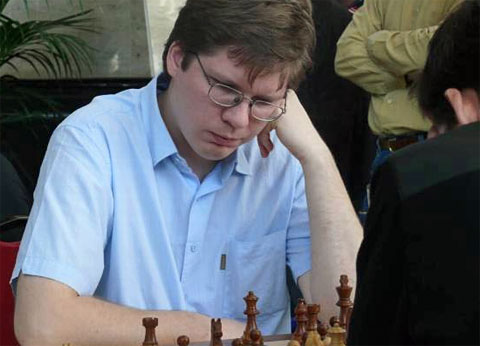 Vladimir Malakhov Vladimir Malakhov - Jonny Hector Politiken Cup, Round 7 Helsingør, 23 July 2009 Slav Queen's Gambit: Tikhi Opening 1.d4 d5 2.Nf3 Nf6 3.c4 c6 4.e3 Bf5
5.Nc3 e6 6.Nh4 Be4
7.f3 Bg6 8.Qb3 b5
9.c5!?
9...Nbd7!?
10.a4 a6 11.Nxg6
11...hxg6 12.Qa3!
12...Qb8?
!""""""""# $t+ WlV T% $+ +m+oO % $o+o+oMo+% $+oPo+ + % $p+ P + +% $+qN Pp+ % $ P + +pP% $R B Kb+r% /(((((((() WHITE: Vladimir Malakhov Position after 12...Qb8 13.axb5!
13...cxb5
14.Nxb5!
14...Rxh2 15.Rxh2 Qxh2 16.Qa5 Qh4+
17.Ke2 Ke7
18.c6!
18...Nh5
19.cxd7 Ng3+ 20.Kd3 Nxf1
!""""""""# $t+ + V +% $+ +pLoO % $o+ +o+O+% $Qn+o+ + % $ + P + W% $+ +kPp+ % $ P + +p+% $R B +m+ % /(((((((() WHITE: Vladimir Malakhov Position after 20...Ng3f1:B 21.Qc7!!
21...Kf6
22.d8Q+ Rxd8 23.Qxd8+ Be7 24.Qc7 g5 25.Nc3 1-0
|
| Printer Friendly | Permalink | | Top |
| Jack Rabbit
|
Sun Jul-26-09 08:14 PM Response to Reply #6 |
| 9. Berg - Nielsen, Round 5 |
 Peter Heine Nielsen Emanuel Berg - Peter Heine Nielsen Politiken Cup, Round 5 Helsingør, 21 July 2009 Epine Dorsal: Horseman Defense 1.e4 e5 2.Nf3 Nf6
3.Nxe5 d6 4.Nc4
4...Nxe4 5.Qe2
5...Qe7 6.Ne3 Nf6
7.b3!?
7...Nc6
8.Bb2 Be6 9.g3
9...d5 10.Bg2 0-0-0 11.d4 h5
12.Nd2 g6 13.0-0-0 Bh6 14.Rhe1 Qb4
15.a3 Qb6 16.Kb1 Rhe8 17.Qd3?!
17...Ng4!?
18.Nxg4 hxg4 19.b4 a5!?
20.bxa5 Nxa5 21.Qc3 Bxd2
22.Rxd2 Nc4 23.Rdd1 Rd6!?
24.Bf1?
!""""""""# $ +l+t+ +% $+oO +o+ % $ W Tv+o+% $+ +o+ + % $ +mP +o+% $P Q + P % $ Bp+ P P% $+k+rRb+ % /(((((((() WHITE: Emanuel Berg Position after 24.Bg2f1 24...Nxb2!
25.Qxb2 Rh8!
26.Re3
26...Qxb2+ 27.Kxb2 Rxh2
28.Rd2 Bf5
29.c4
29...Be4 30.Be2 f5 31.c5 Rd8 32.Bd1
!""""""""# $ +lT + +% $+oO + + % $ + + +o+% $+ Po+o+ % $ + Pv+o+% $P + R P % $ K R P T% $+ +b+ + % /(((((((() WHITE: Emanuel Berg Position after 32.Be2d1 32...Rdh8!
33.Kc3
33...Rh1 34.Bc2 Rc1 35.Kb2 Rhh1 36.Bxe4 fxe4 37.Kb3
!""""""""# $ +l+ + +% $+oO + + % $ + + +o+% $+ Po+ + % $ + Po+o+% $Pk+ R P % $ + R P +% $+ T + +t% /(((((((() WHITE: Emanuel Berg Position after 37.Kb2b3 37...Rb1+!
38.Rb2
38...Rxb2+ 39.Kxb2 Rd1 40.Kc3 Kb8 41.a4 0-1
|
| Printer Friendly | Permalink | | Top |
| Jack Rabbit
|
Sun Jul-26-09 09:41 PM Response to Reply #1 |
| 10. Winner's Circle: Canadian Open, Edmonton |
| Printer Friendly | Permalink | | Top |
| Jack Rabbit
|
Sun Jul-26-09 09:41 PM Response to Reply #10 |
| 11. Hommeles - Bluvshtein, Round 9 |
 Mark Bluvshtein Theo Hommeles - Mark Bluvshtein Canadian Open, Round 9 Edmonton, 19 July 2009 Open Sicilian Game: Najdorf-Scheveningen Defense (Rauzer Opening) 1.e4 c5 2.Nf3 d6 3.d4 cxd4 4.Nxd4 Nf6 5.Nc3 Nc6 6.Bg5 e6 7.Qd2 Be7 8.0-0-0 a6 9.f4
9...Nxd4 10.Qxd4 b5
11.Bxf6 gxf6 12.Bd3
12...Qc7 13.Qe3 Bb7!?
14.f5
14...b4 15.Ne2 e5
16.Kb1 Qc5 17.Qxc5
17...dxc5 18.c4?!
18...0-0-0 19.Bc2
19...Rhg8 20.Ng3
!""""""""# $ +lT +t+% $+v+ Vo+o% $o+ + O +% $+ O Op+ % $ Op+p+ +% $+ + + N % $pPb+ +pP% $+k+r+ +r% /(((((((() WHITE: Theo Hommeles Position after 20.Ne2g3 20...Rd4!
21.b3
21...h5 22.Rxd4?
22...exd4 23.Nxh5 Rxg2 24.Rf1
!""""""""# $ +l+ + +% $+v+ +o+ % $o+ +pO +% $+ O +p+n% $ OpOp+ +% $+p+ + + % $p+b+ + T% $+k+ +r+ % /(((((((() WHITE: Theo Hommeles Position after 24.Rh1f1 24...Rxh2
25.Nf4 Bd6 26.Nd5 Be5 27.Bd3
27...Kd7 28.Rf3 a5 29.Rf1 Bc6 30.Rf3 Kd6 31.Rf1 a4 32.Rd1
!""""""""# $ + + + +% $+ + +o+ % $ +vL O +% $+ OnVp+ % $oOpOp+ +% $+p+b+ + % $p+ + + T% $+k+r+ + % /(((((((() WHITE: Theo Hommeles Position after 32.Rf1d1 32...a3!
33.Bc2 Re2 34.Kc1 Rg2 35.Rd2 Rg4 36.Kb1
36...Kd7 37.Rd1 Ke8 38.Rh1
38...Kf8 39.Rd1 Kg7 40.Rh1 Rg2 41.Rd1 Kh6
42.Ne7 Bb7 43.Nd5 Kg5 44.Bd3
44...Rb2+ 45.Ka1 Kh4 46.Rh1+ Kg3 47.Rg1+ Kf3 48.Rf1+ Kg2 49.Rd1 Kh2
50.Ne7 0-1
|
| Printer Friendly | Permalink | | Top |
| Jack Rabbit
|
Sun Jul-26-09 09:43 PM Response to Reply #10 |
| 12. Proper - Ganguly, Round 9 |
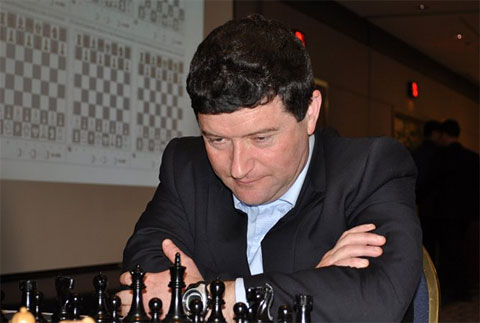 Eduard Porper Eduard Porper - Surya Sekhar Ganguly Edmonton, 19 July 2009 West India Game: King's Indian Defense (Main Line) 1.d4 Nf6 2.Nf3 g6 3.c4 Bg7 4.Nc3 0-0 5.e4 d6 6.Be2 e5 7.d5
7...a5
8.Bg5 h6 9.Be3
9...Ng4 10.Bc1 Na6 11.0-0
11...Nc5 12.g3 Nf6!?
13.Qc2
13...Qe8!?
14.Nh4 Bh3 15.Re1 Nfd7 16.Nb5
16...Na6
17.Bd2 c6 18.Nxd6 Qb8 19.c5 Naxc5
20.Nc4 cxd5 21.exd5 b6 22.Bc3!?
!""""""""# $tW + Tl+% $+ +m+oV % $ O + +oO% $O MpO + % $ +n+ + N% $+ B + Pv% $pPq+bP O% $R + R K % /(((((((() WHITE: Eduard Porper Position after 22.Bd2c3 22...Nb7!
23.b4 Rc8 24.Qb2 Nd6!
25.Nxd6 Qxd6 26.Rad1 axb4 27.Bxb4 Nc5 28.Ng2
28...Bd7
29.Ne3 b5 30.Rc1 f5 31.Red1 f4 32.Bg4 Bxg4?!
33.Nxg4 Na4
34.Qb3!?
!""""""""# $t+t+ +l+% $+ + + V % $ + W +oO% $+o+pO + % $mB + On+% $+q+ + P % $p+ + P P% $+ Rr+ K % /(((((((() WHITE: Eduard Porper Position after 34.Qb2b3 34...Qd7!
35.d6+ Kh7 36.f3 Nb6 37.gxf4 exf4 38.Rxc8
38...Rxc8 39.Re1 Re8?
!""""""""# $ + +t+ +% $+ +w+ Vl% $ M P +oO% $+o+ + + % $ B + On+% $+q+ +p+ % $p+ + + P% $+ + R K % /(((((((() WHITE: Eduard Porper Position after 39...Rc8e8 40.Re7!!
40...Rxe7 41.dxe7
41...Nc4 42.a4!
42...h5 43.Nf2 Bd4
44.axb5 Ne5
!""""""""# $ + + + +% $+ +wP +l% $ + + +o+% $+p+ M +o% $ V B O +% $+q+ +p+ % $ + + N P% $+ + + K % /(((((((() WHITE: Eduard Porper Position after 44...Nc4e5 45.Bd6!
45...Qh3 46.Bxe5!
46...Bxf2+ 47.Kxf2 Qxh2+
48.Ke1 Qg1+
49.Kd2 Qf2+ 50.Kd1 Qf1+ 51.Kc2 Qe2+ 52.Kb1 Qe1+ 53.Ka2 Qe2+ 54.Ka3
54...Qxe5
!""""""""# $ + + + +% $+ + P +l% $ + + +o+% $+o+ W +o% $ + + O +% $Kq+ + + % $ + + + +% $+ + + + % /(((((((() WHITE: Eduard Porper Position after 54...Qe2e5:B 55.Qf7+!
55...Kh6 56.e8Q Qa1+ 57.Kb4 Qb2+ 58.Ka5 1-0
|
| Printer Friendly | Permalink | | Top |
| Jack Rabbit
|
Thu Jul-30-09 12:50 PM Response to Original message |
| 13. Update (Thursday): Vachier Lagrave wins Biel |
 Eighteen-year-old French GM Maxime Vachier Lagrave won the Grandmaster Tournament at the 2009 Biel Chess Festival earlier today in Switzerland. All games in today's tenth and final round were drawn. M. Vachier Lagrave drew each of his first six games and then won in rounds seven and eight while early leader Alexander Morozevich lost then won then lost again through the second half of the tournament and Vassily Ivanchuk, who entered the ninth round tied for the lead with Vachier Lagrave for the top spot, lost to Morozevich to allow the Frenchman to take the sole lead. M. Vachier Lagrave won 2 games with eight draws and no losses for six points. Ivanchuk and Morozevich finished tied for second with 5½ points each. Milos and Felgaer share lead in Pan-Am Championship aft 6 rounds Brazilian GM Gilberto Milos and Ruben Felgaer of Argentina are tied for first place with 5½ points each after 6 rounds in the Pan-American Championship in São Paulo. Fifteen players, including American grandmasters Jaan Ehlvest and Alex Shabalov, are tied for third with 5 points each. The seventh round will start today at 19:00 Atlantic Daylight Time (3 pm PDT). In today's action, Felgaer will play White against Milos. The eleventh and final round is scheduled for Sunday. Official website (only in Portuguese and not well organized). |
| Printer Friendly | Permalink | | Top |
| Jack Rabbit
|
Thu Jul-30-09 06:59 PM Response to Original message |
| 14. Update (Thursday afternoon PDT): Naka new chess960 champ |
 US national champion Hikaru Nakamura put another feather in his cap for 2009 today by winning the world chess960 championship at the Mainz Chess Festival in Germany, Nakamura defeated 2008 chess960 champion Levon Aronian 3½-½ in four games today to take the title after two days of preliminary rounds. Also competing in the chess960 competition were grandmasters Viorel Bologan and Sergei Movsesian. Chess960, also called FischeRandom ehess, is a chess variant developed by the late former world champion Bobby Fischer in which the pieces are placed in a random order at the beginning of the game rather than the traditional chess starting position. The rapid world championship begins in Mainz tomorrow. |
| Printer Friendly | Permalink | | Top |
| DU
AdBot (1000+ posts) |
Thu Apr 18th 2024, 10:19 AM Response to Original message |
| Advertisements [?] |
| Top |
| Home » Discuss » Topic Forums » Sports |
|
Powered by DCForum+ Version 1.1 Copyright 1997-2002 DCScripts.com
Software has been extensively modified by the DU administrators
Important Notices: By participating on this discussion board, visitors agree to abide by the rules outlined on our Rules page. Messages posted on the Democratic Underground Discussion Forums are the opinions of the individuals who post them, and do not necessarily represent the opinions of Democratic Underground, LLC.
Home | Discussion Forums | Journals | Store | Donate
About DU | Contact Us | Privacy Policy
Got a message for Democratic Underground? Click here to send us a message.
© 2001 - 2011 Democratic Underground, LLC